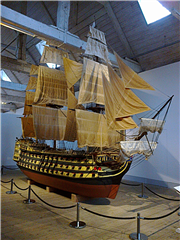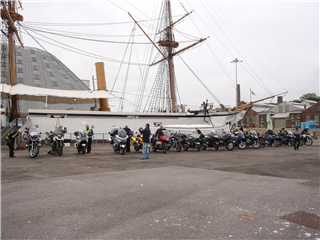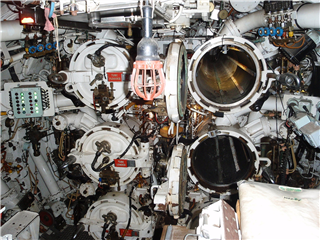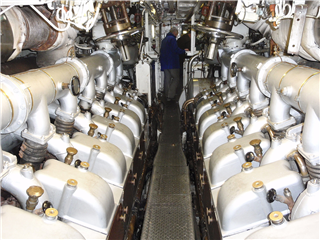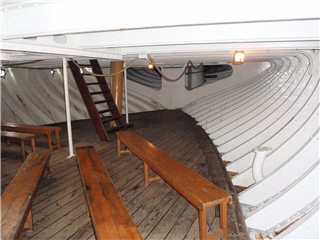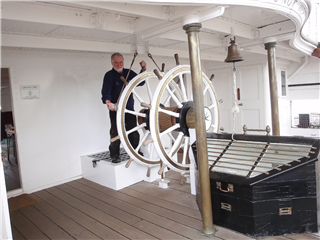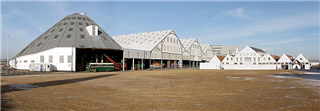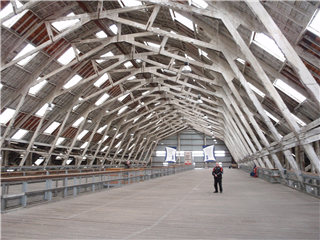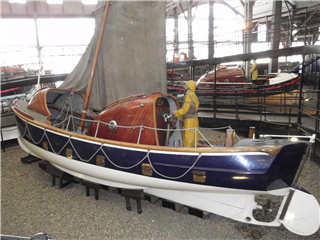BMW Club visit to Chatham Dockyard Museum
Sunday 9th June 2013
Report and photos by Mike Davies, East Anglia Section
Back in the early 1990s I had reason to visit The Chatham Dockyard Museum for business purposes and was impressed with the early development been carried out to establish this excellent museum.
The origins of the Dockyard go back to Queen Elizabeth 1st and the current site was established in 1613. See this link for full information: http://www.thedockyard.co.uk/
The oldest ship still in commission with the Royal Navy is HMS Victory which was built here and launched 7th May 1765.
I then vowed that I would return when they had developed the museum and following a committee meeting late last year I offered to lead a ride-in to the museum.
A week or two later I rode to the museum and met the organizing lady to set up a group visit. The advantage of a group visit is that if we number more than 15 people we obtain a special entry rate.
There is a further reduction for concessions (OAPs!).
I then contacted the South-East and Southern Sections and asked them if they would like to join us.
I drew up an announcement and placed it on the East Anglian website and sent this link to the South-East and Southern sections.
Over the course of the next few months interest developed and on the day of the visit it appeared that we would have some 20 or so people.
Early on Sunday, the 9th of June I rode through light drizzle to the rendezvous point I had arranged for the East Anglian Section and four of us road together to Chatham, a fifth meeting us there later. Fortunately the weather had by now dried up but heavy cloud remained and it was quite cold.
After a short wait the South-East section arrived and shortly after the Southern section also appeared. I counted 17 motorcycles, some with pillions so we qualified for our group price reduction.
After paying our entrance fees, some members having opted to take the Ropery tour (I had already been privileged to take the tour on my first visit to arrange this meeting) we returned to our motorcycles and I led the group into the dockyard to our allocated parking area alongside HMS Gannet, an early steel framed wood planked steam driven warship, built in 1878,
There was no set agenda, people pleasing themselves where they went. The museum is large and it is impossible to see it all in one day. I will recount the areas I looked at with two of my colleagues.
The first call was to the excellent café for a coffee and cake to set us up for the morning.
HMS CAVALIER
Our first port of call after coffee was this Royal Navy destroyer HMS Cavalier.
HMS CAVALIER was one of ninety-six war emergency destroyers built for the Royal Navy during the Second World War. Awarded the Battle Honour ‘Arctic 1945’ for operations off northern Norway and in support of the homeward-bound Russian convoy RA64, CAVALIER later operated in the Western Approaches, undertaking duties which included the high-speed escort of the liners-turned-troopships RMS Queen Mary and RMS Queen Elizabeth. In the 1960s she won a race to become the fastest ship in the Royal Navy at the time.
HMS SUBMARINE OCELOT
We had booked a timed tour of this interesting ship.
HM Submarine Ocelot was laid down at Chatham Dockyard on the 17th of November 1960. She was launched two years later in May 1962 from No. 7 Slip. Significantly Ocelot was the last submarine to be built in Chatham Dockyard for the Royal Navy. Ocelot paid off in August 1991 and returned to Chatham Historic Dockyard in 1992.
One of the thirteen Oberon Class submarines built for the Royal Navy between 1959 and 1964. The Oberon Class were all diesel electric boats which were capable of high underwater speeds of up to 17 knots (20 mph) when submerged. They also carried improved detection equipment over their predecessor the Porpoise Class, and were armed with homing torpedoes. We were told that these submarines were quieter than today’s modern nuclear subs!
The tour led us from one end of the sub to the other, starting at the front torpedo tube area,
through ratings messes, the engine room
and bridge area where it was possible to look through the attack periscope and see our bikes by HMS Gannet!
Next we boarded HMS Gannet.
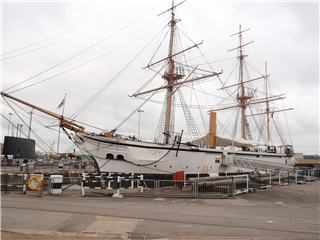 HMS
Gannet, an Osprey/Doterel class sloop, was ordered by the Admiralty on 14th
February 1876 and constructed at Sheerness Royal Dockyard. Laid down in
December 1876 and launched 20 months later on 31st August 1878, HMS Gannet
commissioned as an operational unit of the Royal Navy for the first time on the
17th April 1879.
HMS
Gannet, an Osprey/Doterel class sloop, was ordered by the Admiralty on 14th
February 1876 and constructed at Sheerness Royal Dockyard. Laid down in
December 1876 and launched 20 months later on 31st August 1878, HMS Gannet
commissioned as an operational unit of the Royal Navy for the first time on the
17th April 1879.
In May 1879, she sailed from Portsmouth, via the Atlantic Ocean, for the Pacific port of Panama. In 1885, following a two-year refit, Gannet re-commissioned at Sheerness and sailed for the Mediterranean Station, where she was initially used in fleet support duties to General Graham's forces in the Sudan and in slavery patrols, before being ordered to join the squadron protecting the Sudanese port of Suakin.
Recalled from a mid-commission refit at Malta, Gannet
relieved HMS Dolphin at Suakin on the 11th September 1888 and on the 17th
September, opened fire with her Poop deck 5" guns in support of land
forces against an attack by rebel forces. During the following 27 days Gannet's
main armament fired over 200 shells and her Nordenfelt machine guns fired
nearly 1,200 rounds in the defence of Suakin. HMS Starling relieved Gannet on
the 15th October. Although Osman Digna's rebel forces were not defeated until
December 1888, the siege was lifted and with it the immediate threat to Suakin.
Without Gannet's assistance the port of Suakin may well have fallen to the
rebel besiegers.
HMS Gannet paid off at Malta on the 1st November 1888.
BUILDING SHEDS
We then made our way to the Building Sheds, the largest of which is an amazing wooden structure built over the slip from which HMS Victory was launched. Housed here now are collections of Lifeboats from many ages, fire engines, large engineering machinery and much more.
MODEL EXHIBITIONS
Here are an excellent and varied collection of first class models of ships and machines from all ages. We were told that the collection is on loan from the Greenwich Maritime Museum, which was totally re-vamped some years ago, with all boats and models being distributed to various places, some here at Chatham and other to Falmouth. In all Chatham has some 3000 models – you can’t see many of them at present! Sorry no photos as the display areas are rather dark!
The time was now 3.30pm and we had arranged to meet in the café for a cup of tea before we left for home. We also had lunch here earlier and I can say it is very good value.
The Chatham Dockyard Museum is a very interesting place and well worth a visit. It is hard to
See everything in a day so I will be returning in the future.
My thanks to Shaun from the South-East Section who arrived with the largest number of attendees and to Godfrey who organised the Southern Section.
